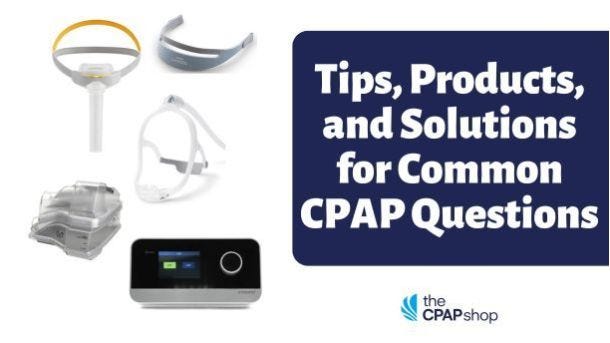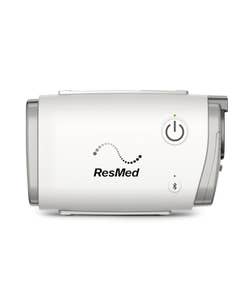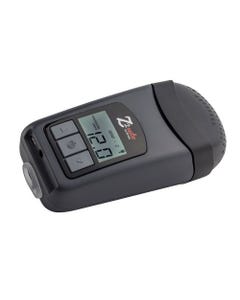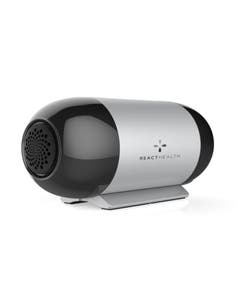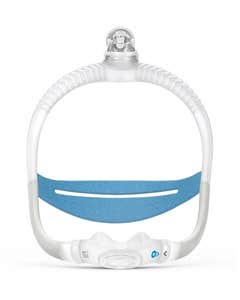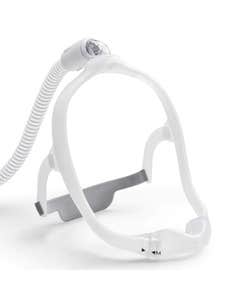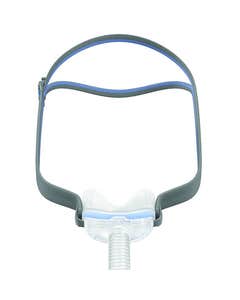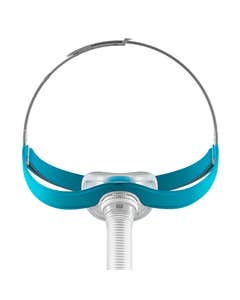Tips, Products, and Solutions For Common CPAP Questions
Sleep apnea is a condition where a person’s airway collapses during sleep, which leads to periods where the individual stops breathing. According to the National Sleep Foundation, more than 18 million Americans are affected by sleep apnea. This increasingly common sleep disorder is linked to several comorbidities, including high blood pressure, heart disease, and increased risk of death. Continuous positive airway pressure (CPAP) is the preferred treatment for sleep apnea, but adherence remains low.
Common CPAP Questions, Problems, and Solutions
Why Do I Have Red Marks on My Face?
Problem: Mask contact on the skin can leave red marks. Tighter-fitting CPAP masks, typically due to users adjusting their headgear too tightly, can leave deeper red marks and soreness. CPAP masks that fit tightly (or too loosely!) can be uncomfortable.
Solutions:
- Adjust Strap Tension: loosening the tension on headgear can relieve pressure on your face and reduce red marks and discomfort. If your straps are not adjusting properly, it may be time for new headgear. Explore replacement headgear for your CPAP mask here.
- Use Padding: padding accessories can help soften mask contact points and reduce redness and soreness. Explore padding products.
- Explore Different Mask Styles: it can take time to find the ideal CPAP mask. Try out different mask types to see which one provides the most comfort. Find CPAP masks.
- Moisturize Skin: you can reduce redness and soreness with skin moisturizers applied around CPAP mask contact points in the nostrils. Use nasal moisturizer.
- Consult Healthcare Provider: If the above solutions do not work, peak with your doctor about pain or red marks from CPAP masks. Your doctor can offer some recommendations based on your current equipment.
Why is My CPAP Mask Leaking?
Problem:
A loose CPAP mask or one with damaged seals allows air to seep out through gaps, which can compromise the effectiveness of CPAP therapy. Mask leaks can also reduce air pressure from your CPAP machine, so you are not attaining the recommended pressure setting of your prescription.
As a result, patients may overtighten masks to try and stop the leak, which can lead to discomfort skin redness, and soreness.
Solutions:
- Ensure proper mask fit: make sure that your CPAP mask fits securely to prevent leaks. If you need to overtighten your mask to stop leaks, then it may be time for a new one. Explore replacement CPAP masks.
- Address skin issues: if you experience frequent red marks or soreness on your skin, be sure to address these issues with padding or skin moisturizers. Explore comfort products.
- Maintain mask hygiene: a dirty CPAP mask can lead to poor performance. Be sure to keep all your CPAP equipment clean, especially your mask. Find cleaning options.
- Explore alternative mask options: finding a good mask fit helps prevent leaks. Find a CPAP mask that fits without overtightening.
- Try the AR Mask Fit with virtual face scanning technology: a new 3D facial scanning capability can help you determine the best fit for your CPAP mask, eliminating trial and error. Learn more about the AR Mask Fit.
- Consult with a sleep therapist or CPAP provider for personalized solutions: your doctor or sleep therapist can provide recommendations that can end leaks and improve CPAP compliance.
Why is My CPAP Machine Making Noise?
Problem: CPAP machines can sometimes be loud, which can disrupt your sleep and the sleep of your bed partner.
Solutions:
- Check the machine's filter for dirt or blockages: clean or replace your filter if you notice it is worn out or damaged. Keeping your CPAP machine clean and replacing dirty filters may help reduce the noise. Find replacement filters.
- Ensure the mask, tubing, and connections are properly assembled and secure: check your machine connections, loose mask and tubing connection points may cause air pressure to whistle. Replace parts as needed. Find replacement parts.
- Inspect the tubing for any leaks or holes: replace them if damaged as tubing with holes can cause noise. Replace tubing as needed. Find replacement tubing here.
Why Do I Have Dry Mouth?
Problem: The dry air of CPAP therapy can leave your mouth feeling dry, especially if you are a mouth breather. The dry air flow all night long dehydrates the mouth and throat. Dryness can disrupt sleep and may also lead to dental problems if left untreated.
Solutions:
- Adjust the CPAP settings: you can adjust your CPAP machine to reduce air pressure, which may help reduce dryness. Check with your doctor first. Make sure your CPAP machine provides a range of settings that fit your therapy needs.
- Use a heated humidifier: heated humidifiers can moisten the airflow and help reduce dry mouth.
- Stay hydrated: drinking plenty of water can help you stay hydrated during CPAP therapy and reduce dryness.
- Try using a chin strap to keep your mouth closed if you are a mouth breather. Keeping your mouth closed helps maintain hydration and reduces dry mouth.
- Try medication: Some over the counter medications can be beneficial to help with this. Check with your healthcare provider which medication is best for you.
Why is There Water in My Tubing?
Problem: Condensation can build up in CPAP tubing when a humidifier is used in conjunction with a CPAP machine. The condensation can lead to a backup of water into the machine itself, which can cause damage. The problem can also cause splashing and gurgling noises during therapy which can be disruptive to sleep.
Solutions:
- Adjust the CPAP machine's humidity settings to minimize condensation: making some minor adjustments to your CPAP machine’s humidity settings may solve the problem. You can find CPAP machines with built-in humidifiers with auto options to help manage humidity effectively without adjusting. Try a machine option with auto features.
- Use a CPAP hose cover to insulate the tubing and reduce condensation: insulating your CPAP tubing can help prevent ambient temperatures from causing condensation.
- Elevate the CPAP machine or tubing to prevent water from flowing back into the device: by elevating your CPAP machine, you can prevent water from backing up into the machine and help protect it from damage.
- Use a CPAP hose with a built-in heated wire to maintain temperature and prevent condensation: heated tubing can prevent condensation buildup..
Why am I Removing My CPAP Mask Unintentionally?
Problem: Discomfort with CPAP, especially among new patients, often hinders CPAP compliance. Patients may wake up at night and remove their mask. By removing the mask, they suffer from more sleep apnea episodes as they use CPAP less than recommended by their doctor, which reduces the effectiveness of therapy.
Solutions:
- Try different mask styles: new patients especially should experiment with different mask types to find one that is the most comfortable.
- Use mask stabilizers: a mask stabilizer helps keep CPAP masks secure and less likely to slip off your face and lead to removal. Explore mask stabilizer options.
- Try different sleeping positions: how you sleep can affect the comfort of your CPAP mask. Try sleeping on your back or side to reduce mask pressure on your face.
- Practice relaxation techniques: much of the discomfort with CPAP masks is due to anxiety about therapy. Try relaxation methods such as meditation or simple breathing exercises to reduce anxiety.
Why Am I Having Difficulting Falling Asleep?
Problem: Starting out with CPAP therapy can be difficult, especially trying to fall asleep for the first few nights. The mask can feel uncomfortable. You may also experience dryness or throat or nose irritation from the dry air of the CPAP machine. Ideal pressure settings can take some time to discover, and you may change them frequently. Also, having a CPAP machine at your bedside means getting accustomed to an unfamiliar noise that can keep you awake.
Solutions:
- Try different types of masks (nasal, nasal pillows, full-face) to find the most comfortable fit: different mask styles can be more comfortable for different people. Feel free to try different types of masks until you find the ideal one.
- Use a heated humidifier to alleviate dryness and irritation: heated humidifiers help reduce the dryness of CPAP air. Find a heated humidifier.
- Gradually increasing CPAP pressure settings to acclimate to therapy: getting used to CPAP therapy requires gradually adjusting pressure settings. You can also use a CPAP machine with a ramp feature that can help you ease into higher-pressure settings.
- Use a CPAP machine with quieter operation or employ white noise machines: quieter CPAP machines are available. Find one with a lower decibel level.
Why am I Feeling Claustrophobic?
Problem: Wearing a CPAP mask can feel claustrophobic. There may be an unfamiliar feeling of tightness. You may feel like you cannot breath like you normally do when going to sleep. These sensations can lead to discomfort and feelings of anxiety.
Solutions:
- Adjust Mask Fit: take time to adjust your CPAP mask properly so it fits comfortably. Follow the fitting and adjustment guidelines provided with the mask.
- Gradual Acclimation to Therapy: do not expect to experience CPAP therapy comfortably right away. Be patient. Gradually adjust to CPAP pressure settings by starting at a lower setting one night and working your way slowly to higher settings. A CPAP machine with a ramp feature can help.
- Relaxation Techniques: focus on relaxation. Breathing exercises and meditation before bedtime can relieve feelings of anxiety and claustrophobia.
- Wear During the Day: getting used to the feeling of CPAP treatment can be made easier by easing into the transition. Put the mask on for short durations during the day so the feeling becomes more and more familiar.
- Seek Professional Help: therapists can help you adjust to the unfamiliar feeling of wearing a mask and breathing pressurized air while you sleep.
Why Do I Have a Stuffy Nose?
Problem: A stuffy nose is a common problem with CPAP therapy. You may have trouble breathing due to nasal congestion, which can interrupt your sleep and reduce the effectiveness of CPAP therapy
Solutions:
- Nasal Decongestants: you can use nasal decongestants to help with symptoms.
- Nasal Saline Rinse: nasal saline rinses help reduce nasal congestion.
- Nasal Mask Options: different nasal CPAP masks can help improve comfort.
- Elevate Head Position: elevating your head while you sleep can help drain nasal passages and make sleeping more comfortable.
How Do I Combat my Difficulty Tolerating Forced Air?
Problem: Breathing forced air from a CPAP machine can be difficult. You may feel like you are suffocating and dislike the sensation of blowing air in your nose and mouth. This feeling can often lead to patients abandoning CPAP therapy.
Solution:
- Nasal Masks or Pillows: nasal CPAP masks or nasal pillow masks can be helpful alternatives to a full face mask.
- Expiratory Pressure Relief (EPR) or Flex: some CPAP machines feature expiratory pressure relief which reduces pressure during exhaling, which is a common complaint.
- Mask Fit and Adjustments: make sure your mask fits well and that it is properly adjusted to your face.
- Breathing Exercises: conducting breathing exercises before bedtime can help you adapt to CPAP therapy.
Conclusion
At The CPAP Shop, most of our CPAP machines and accessories come with an initial set-up kit including some with a live conversation with a sleep coach. After allowing for time to get used to the therapy, most lingering complaints can be alleviated with some simple machine or mask setting adjustments. However, in some cases, you may need a little extra help.
Adherence to CPAP therapy is vital to your continued health. These products may help make it a little easier to adjust. As always, our knowledgeable staff is just a phone call away! Contact us at 866-414-9700.



